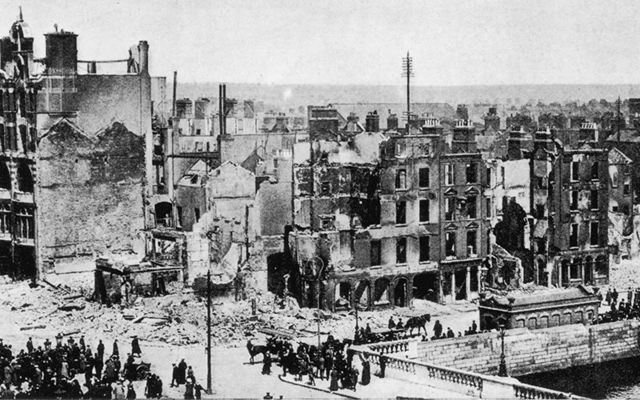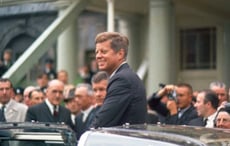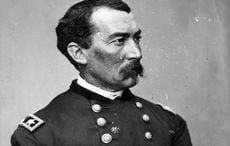In his new book, A New Ireland, Niall O’Dowd, examines how the Catholic Church first saw the rebellion of 1916 as "senseless, meaningless debauchery of blood."
Dublin, Easter Monday 1916, 11:00 a.m.: Around 1,250 members of the Irish Volunteers and Irish Citizen Army, including 200 women from Cumann na mBan (translates as the Women’s Association), assembled across Dublin.
About 150 rebels, under James Connolly and Patrick Pearse, two signatories to the Proclamation of the Irish Republic marched up Dublin’s main thoroughfare, O’Connell Street, as far as the Imperial Hotel. Connolly gave a sudden command to wheel left and charge the General Post Office. The Easter Rising had begun, and nothing would ever be the same again after 800 years of continuous British rule.
Patrick Pearse, a 37-year-old schoolteacher, and writer, as president of the new Republic, stepped outside the GPO and read the historic proclamation that begins with the iconic “Irishmen and Irishwomen.” For the first time in any revolutionary proclamation up to that point in history, women were included.
A small crowd gathered some cheered, some were hostile but silent. This rising was not popular at first, as many families had members fighting in the Great War and this tumult looked like treachery. Stephen McKenna, an eyewitness, noted about Pearse, “For once his magnetism had left him; the response was chilling; a few thin, perfunctory cheers, no direct hostility just then, but no enthusiasm whatever.”
Within the first hour of the rebellion, rebels stormed and occupied several of the capital city’s most important political and economic buildings: Jacob’s factory, the Four Courts, Stephen’s Green, the South Dublin Union (now St. James’s Hospital), Jameson Distillery, the Mendicity Institute, Boland’s Mills and Bakery, plus 25 Northumberland Road and Clanwilliam House.
The British poured in reinforcements, and after six days with Dublin burning and in ruins, the Rising was over, but in the words of Yeats, “All changed, changed utterly.”
The Vatican blundered badly with its first statement, as historian Oliver J. Rafferty S., J of Boston College noted:
"The Secretary of State at the Vatican, Cardinal Pietro Gasparri, sent a telegram on 30 April to the Archbishop of Armagh, Cardinal Michael Logue, asking the Irish hierarchy to cooperate with the authorities in reestablishing law and order and not to inhibit the task of the government in subduing the rebels. … The first telegram was leaked to the … British and Irish newspapers. In some Irish Catholic circles, it generated hostility and resentment."
Seven bishops bowed to the instruction from Rome and rushed to condemn the rising. The Bishop of Ross said it was “senseless, meaningless debauchery of blood.” The Bishop of Ardagh called it a “mad and sinful adventure.” The Bishop of Kerry declared the leaders “evil-minded men.” The Bishop of Kildare stated it was “a mad insurrection.”
However, the majority waited to see which way the wind was blowing, and as the executions commenced, the public and Hierarchy’s mood switched. They realized they had badly misread the mood of the country and misunderstood the intense wave of nationalism that was sparked by The Rising. Bishop O’Dwyer of Limerick, previously anti-Republican, was dismayed by the mass executions and did a volte-face.
After the Easter Rising, General John Maxwell, the effective ruler of Ireland after martial law was declared, continued to order executions, despite desperate pleas for mercy from families and some clergy. He wrote to Bishop O’ Dwyer on May 6, demanding that “he restrain two priests in his diocese,” whom the General regarded as a “dangerous menace.” He accused them of involvement in subversive activities and threatened to arrest them. The Irish Times reported that in his letter of reply (which he had published), the bishop defended his priests and rejected Maxwell’s appeal for help “in the furtherance of your work as a military dictator of Ireland. Even if the action of that kind was not outside my province, the events of the past few weeks would make it impossible for me to have any part in proceedings which I regard as wantonly cruel and oppressive.”
O’Dwyer became an overnight hero. It could have been too little too late, but the hierarchy was fortunate with the sequence of events that happened.
How did the church miss the shifting paradigm? Arrogance at the very top, the belief that the citizenry was docile and would never go against the church teaching that violent revolution was wrong. After all, the Fenians had been excommunicated for defying this rule, and it was thought that this new generation would never risk such a punishment.
Nobody thought that this era would subsequently be called “The Celtic Revival,” because Irish language revivalists like Douglas Hyde (later to become Ireland’s first president) and great literary figures like the poet Yeats and the playwright J.M. Synge joined revolutionaries like Pearse and Connolly in transforming culture and belies. They were further strengthened by a new and powerful force, the newly minted Irish Diaspora.
Back in 1892, Irish nationalist and Australian politician Sir Charles Gavan Dufy wrote presciently that the younger generation of Irish were “beginning” to reassert and examine their Celtic roots.
"A group of young men, among the most generous and disinterested in our annals, are busy digging up the buried relics of our history, to enlighten the present by a knowledge of the past, setting up on their pedestals anew the overthrown statues of Irish worthies, assailing wrongs which under long impunity had become unquestioned and even venerable, and warming as with strong wine the heart of the people, by songs of valor and hope; and happily not standing isolated in their pious work, but encouraged and sustained by just such an army of students and sympathizers as I see here today."
He was part of a new phenomenon the church was dimly aware of—the newly formed Irish Diaspora. The famine, mass deportations, and post-famine migrants had meant that the Irish footprint had now spread across the globe. The Diaspora members’ outlook was militant and radical (not surprisingly given their origins in the wake of the famine or the British attempt at genocide as many considered it). They embraced the rising and many were wary of the hierarchy for their ex-communications of Fenians, even those living in the US, and the too cozy arrangement that existed between the church and the British overlords.
In New York, leaders like John Devoy, an old Fenian warrior, controlled vast funds and loyalty and constantly plotted the next revolution. He was a powerful presence in Ireland though exiled in America. Like many of the 1916 leaders, he was also no admirer of the Catholic hierarchy—in 1865 he had been denounced from the pulpit of Our Lady and St. David’s Catholic Church in Naas, Co Kildare.
There were many who wound the clock for the Easter 1916 Rising, but the man who made it strike was Kildare native, Devoy. Like many of the 1916 women and men, he was not cowed by Mother Church. This was the big worry and fear for the clerics. What if their writ stopped running?
There was not a single Irish event of resistance to British rule that Devoy was not of throughout his long life (he lived to age eighty-six).
He was a chief funder of the Easter Rising, and one of the first people informed by the Irish Republican Brotherhood of the proposed date of the 1916 Uprising. In his biography Irish Rebel by author Terry Golway, Devoy vividly recalled meeting an emissary from Ireland in a New York restaurant and realizing with mounting excitement as he deciphered the coded message that the Rising was to go ahead. His was a very important voice, likely the person who inspired the words in the Easter proclamation that acknowledged “our exiled children in America.”
Devoy’s issues with the church were reflected by many in the Rising. The challenge to the church was considerable. The Irish Parliamentary Party, partly nationalist post-Parnell, was lockstep with the church. Its leader, John Redmond, had urged the Irish to fight for the British in the First World War “urging young Irish to join up and ‘account yourselves as men, not only in Ireland itself but wherever the firing line extends.’” The hierarchy likewise urged young men to fight for Catholic Belgium.
The leaders of the Easter Rising were a different breed. As Devoy, several had felt the backlash of the church and had little affection for the hierarchy. Of the leaders of the 1916 revolution, James Conolly, commander of the Irish Citizen Army and a leading figure in the labor movement as well, was the fiercest critic of the Catholic hierarchy and a dangerous opponent to them. He summarized his views in a pamphlet on “Revolution and the Church.”
"In all the examples covered by this brief and very incomplete retrospective glance into history the instincts of the reformers and revolutionists have been right, the political theories of the Vatican and the clergy unquestionably wrong. The verdict of history as unquestionably endorses the former as it condemns the latter. And intelligent Catholics everywhere accept that verdict. Insofar as true religion has triumphed in the hearts of men it has triumphed in spite of, not because of, the political activities of the priesthood. That political activity in the past, like the clerical opposition to Socialism at present, was and is an attempt to serve God and Mammon—an attempt to combine the service of Him who in His Humbleness rode upon an ass, with the service of those who rode roughshod over the hearts and souls and hopes of suffering humanity."
Thomas Clarke, the oldest man to sign the proclamation and the guiding light behind the Irish Republican Brotherhood, the largest unit in the Rising, died without Catholic church rites after he ejected a priest from his death cell for asking him to apologize for the Rising.
Another one of the seven leaders of the Rising had strong views on the church, even though earlier he had seriously contemplated entering a seminary. Thomas MacDonagh, a school teacher, was far too radical for the church’s liking.
Historian Shane Kenna noted: “MacDonagh was involved in several political crusades including labor politics, women’s suffrage, and cultural nationalism. In 1908, he was hired as deputy principal in Patrick Pearse’s revolutionary educational project ‘Scoil Éanna.’” [5]
Pearse, the leader of the Rising, was a religious-nationalist who cast much of the struggle in a quasi-religious context. However, his social thinking was radical and was becoming even more so under Connolly’s influence. The bishops would have been wary of him, too.
Indeed, all seven men who signed the proclamation were far more radical in social outlook. They were heavily influenced by freethinkers of the French and American revolutions as well as by the flaming rhetoric of Wolfe Tone, which had upset the church back in 1798.
The seed for the 1916 rising was sown in 1913 at a Tone commemoration at which Pearse spoke and stated bluntly, “We pledge ourselves to follow in the steps of Tone, never to rest either by day or night until his work be accomplished, deeming it the proudest of all privileges to fight for freedom, to fight not in despondency but in great joy hoping for the victory in our day.” [6]
Most of the sixteen leaders executed after the Rising shared suspicions about the role of the Hierarchy. One young man, Michael Collins, too junior in the ranks to be executed, would sometime later advocate killing an anti-Republican bishop and wrote a scathing paper about the Hierarchy, suggesting maybe they should be “exterminated.”
Collins, once a fierce opponent of the church, was outraged by its decree of ex-communications and condemnations of Republicans. However, once he commenced his love affair with the devout Kitty Kiernan, his tenor changed completely, and he ended up a daily Mass goer and communicant.
One wonders if he had survived the Irish Civil War, would he have been as much a supplicant to the Church as his great rival Eamon de Valera became?
American-born, Eamon de Valera was an orthodox knee-bending, ring-kissing, devout mass goer, and hierarchy supporter. He was the person who stood out as the highest level leader not executed after the rising was over, most likely spared from execution by his American birth.
It is tempting to wonder what kind of Ireland it would have become if Connolly had been spared? There were sixteen potential leaders shot before de Valera. Gerry Adams, the modern-day leader who revived Sinn Fein, thinks it would all have turned out differently. In an interview with the author he stated:
"… [A] very important point is when the British came in and actually executed the 1916 leaders. It wasn’t just a knee-jerk sort of imperial reaction. It was quite ruthless and it removed—and I think it was quite deliberate—the main thinkers and writers of the period.
"It removed the republican cohort, the revolutionary leadership that had succeeded, against all the odds, in organizing the rising and in making the Proclamation.
"… This particular group of men and women who actually pushed the issue and the 16 that were killed were the real leaders."
Maire Comerford of Cumann na mBan, the women’s revolutionary group, has written that it was little wonder that there was a counter-revolution because—and she was talking about de Valera—those who ended up coming into power weren’t of the same caliber in leadership ability as demonstrated by the heroic men of the 1916 Rising, who subsequently signed the Proclamation.
Adams stated:
"I stand in amazement of them. They were just enormous. I heard James Connolly described them as the golden generation, you know, and they really were. They were just so idealistic and brave.
"Well, Connolly and Pearse stand out but the two states that evolved in Ireland (Northern Ireland and the Republic of Ireland) had very different ideals from those of the 1916 leaders because of the counter-revolution
"There were two very mean-spirited, really nasty little conservative states set up. When you think of all the authors that were banned … it had become a very intolerant country.
"No wonder so many people left. …
"So for me, that was the counter-revolution personified in that type of state. Understandably, the focus was on the Orange State, but what was happening in the south was absolutely horrific too. If you read … the Peadar O’Donnells and the Seán Ó’Faoláins and the Frank O’Connors you get some sense of what was really going on, and then we didn’t even know about the Magdalenes, etc. [It could have been different] after 1916, but the leaders like Connolly and Pearse were gone."
* “A New Ireland” the new book by Niall O’Dowd, IrishCentral Founder will be launched March 10, 2020, and can be preordered on Amazon or from bookstores.




Comments